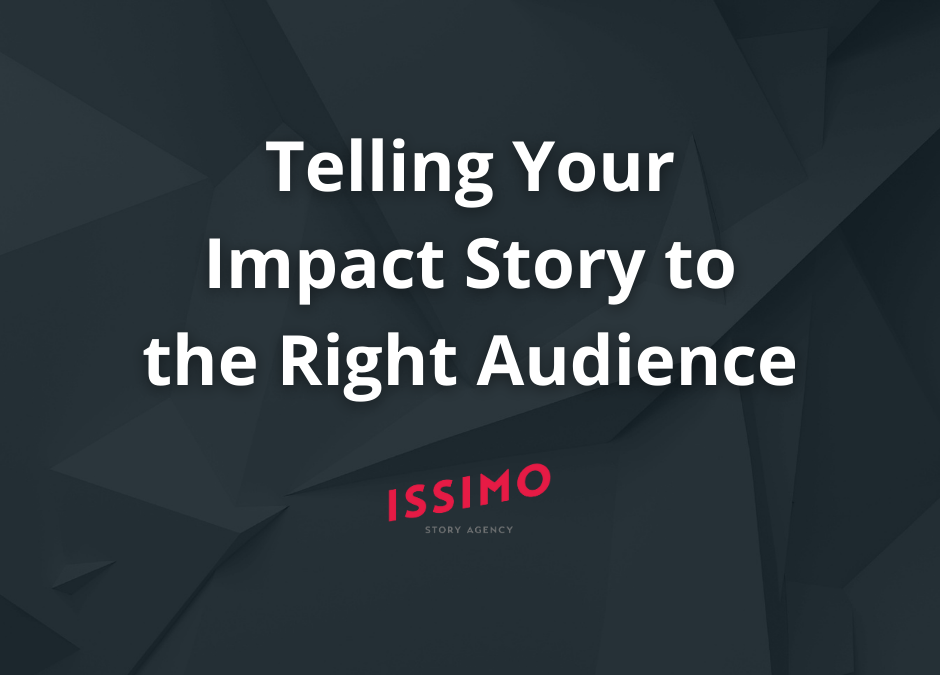Telling Your Impact Story to the Right Audience
About 10 years ago, just being in the impact space was enough of a differentiator to make you stand out. That’s no longer the case. Although it’s a good thing that sustainability and social responsibility are becoming more mainstream, that also means it’s a much more crowded space.
At ISSIMO, we used to see impact organizations asking for help explaining their impact and convincing others to believe in their mission. Now the most common request we get is how organizations can stand out from all the noise.
We recently conducted an attitudinal research study to understand what’s working, what’s not and—most importantly—see how leaders in impact and for-good organizations can be more effective fundraisers.
We believe that the secret to successful fundraising is to tell the right impact story in the right way to the right people. This story helps you zig when others zag and positions you as relevant, unique, credible, and trusted. By differentiating yourself in your own space and connecting with your unique audience, you’ll undoubtedly make an impact. In today’s blog post, we’ll dive deeper on how to do just that.
Differentiating With Impact Storytelling
The foundation of impact storytelling is that the story must ring true to your organization and your audience — whether it’s investors, donors, volunteers or partners. But before you communicate your story to the masses, you must look inward and be authentic.
Be Yourself, Not Them
Each human has a unique DNA sequence that sets them apart from any other person. Organizations, made up of diverse humans with their collective culture, experiences and skill sets, each have a unique DNA as well. Your job as an impact organization is not to be whatever flavor of the month the market seems to want. Instead, it’s to be clear about what you stand for and find those who care about that just as much as you do.
At the most recent GIIN Investor Forum, the CMO of a well-known impact asset management firm asked, “How can you work for us and our competition?” A great question. At ISSIMO, our role as a story agency is to bring forth your organization’s unique story to help attract those for whom you are uniquely positioned to serve — that will be different for each company.
Show Differences Visually
Differentiation is a balance. You must be similar enough to be seen as relevant and part of the industry yet different enough not to be lost in a sea of sameness.
Here’s an example: The unofficial uniform for the financial industry is a blue suit. Showing up to an investor conference wearing a tank top and flip-flops would make you stand out but not in a good way because you wouldn’t be seen as belonging to the group. On the other hand, showing up in a blue suit with a hot pink tie and sunglasses would communicate that you belong, but you’re not the average financial investor.
As you think about those things that make you different from your competitors, find ways to communicate them visually. Start with a visual audit of 10 of your competitors’ websites. What colors do they all use? What fonts? What are their headlines? Often, they all blur together; you could swap the logos for any of them and not notice. When you’re different and have unique value to bring to the world, show it and make it evident.
Start by Asking
To help identify what makes your impact organization different, ask current investors, donors and customers why they chose you instead of a competitor. You could ask them other questions: What is it about us that creates more value for you? How would you describe us to a friend? Take notice of their vocabulary and use that language to craft your story.
One of the most eye-opening research findings is that only one in three impact organizations say they’re very good at fundraising. Additionally, one in two want their organizations to try new approaches to get their impact story out to investors and donors. As a result, most mission-driven organizations could use help to be more effective fundraisers.
Differentiating With Delivery
If a tree falls in the woods and no one hears it, does it make a sound? On the other hand, if you have a great story and no one hears it, does it make an impact?
Once you’ve clarified how your organization differentiates itself and created your brand story, the next step is communicating it consistently and effectively. That means leadership, employees and external stakeholders like investors and donors must all be on the same page about what you do, why you do it, and your impact.
If you’re like most impact organizations in our research study, there’s an exponential decline in impact objective clarity the further you get from the organization’s core. It’s called the Clarity Decay Curve. Our research shows that only half of impact fundraisers have a clear understanding of their organization’s impact objective, but 25 percent believe others in their organization do have that understanding. When the message travels outside organizations to investors and donors, only 13 percent have a perfect understanding of the impact objective.
The takeaway: Telling an organization’s story is difficult without everybody being on the same page. Securing buy-in is challenging, and making the impact you want is nearly impossible.
Instead, ask yourself this: What is the best delivery medium for your story? It’s the one that is best suited to reach your audience where they’re at and inspire the action you desire. Keep your options open. For responsAbility Investments AG, they wanted to breathe new life into the standard investor relations PDF report. They embraced an interactive web “story scrolling” approach for their impact report called “Generation 2030” which allowed them to embed video clips, scrolling animation and graphics. Take a lesson from them as you consider differentiation with your story delivery — there are many more options nowadays than just PowerPoint.
Closing Thoughts
Now that you have strategies for differentiating yourself effectively using your impact story, you have one more reason to dismantle that budget and resource barrier (i.e., thinking that bigger budgets make someone a more effective fundraiser). In our next blog, we’ll take the foundation we’ve laid in the last few months and explore how to tell the right story in the right way.
To learn more about each segments’ behaviors and how you can tell the right story, check out our entire executive summary. And to explore the data yourself, check it out here.

